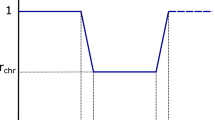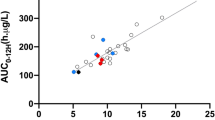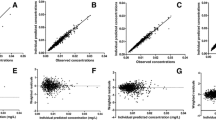Abstract
Background and Objectives: Therapeutic drug monitoring is applied to a range of drugs. To predict an appropriate dosing regimen, models based on Bayesian techniques have been used. However, this approach requires a well trained professional and sophisticated software. The objectives of this study were first to develop kinetic nomograms as a useful tool to achieve individual drug blood concentrations within the therapeutic window, using few samples and in a short period of time; and second to evaluate the performance of these nomograms in dosage adjustment and compare them with the Bayesian procedure by use of simulation.
Methods: Kinetic nomograms involve collection of concentration-time profiles following repeated administrations of a fixed identification protocol and targeting of a steady-state concentration. The profiles divide the concentration-time space into several areas, each of them corresponding to a given adjusted drug dose. Kinetic nomograms are grounded on the statistical description of the interindividual variability provided by population pharmacokinetic approaches. To use them, the assayed drug concentration in a blood sample is first located in the kinetic nomogram and then the dose corresponding to the area containing this location is read. Evaluation of performance and comparison with the traditional Bayesian procedure were done by a simulation study using the immunosuppressant drug sirolimus (rapamycin). All calculations were performed by use of Matlab software.
Results: The simulation study confirmed the need for individual dosage adjustment; 71.6% of individuals underwent modification of the identification protocol of 1 mg twice daily in order to reach steady-state trough concentrations of 8 ng/mL. When the regimens were adjusted by kinetic nomograms and the Bayesian procedure, the steady-state trough concentrations of sirolimus showed low variability (coefficients of variation [CVs] of 23.4% and 24.0%, respectively) as compared with those obtained by standard recommended protocols of 4mg once daily (CV 68.6%). The doses adjusted by kinetic nomograms and the Bayesian procedure were linearly linked and highly correlated (r = 0.96), and both provided simultaneous control of minimum and maximum drug concentrations (63.9% and 68.7% of cases between 6 and 20 ng/mL, respectively).
Conclusion: Kinetic nomograms allow rapid and reliable dosage adjustment after the start of drug therapy. They are interesting alternatives to the cumbersome Bayesian procedure, and they provide dosage adjustment even for drugs that exhibit large intraindividual variability. In the clinical context, kinetic nomograms render individual dosage adjustment a simplified bedside application, and they could assist population studies aiming at dose individualization.




Similar content being viewed by others
References
Kang JS, Lee MH. Overview of therapeutic drug monitoring. Korean J Intern Med 2009; 24(1): 1–10
Spector R, Park GD, Johnson GF, et al. Therapeutic drug monitoring. Clin Pharmacol Ther 1988; 43: 345–53
Alnaim L. Therapeutic drug monitoring of cancer chemotherapy. J Oncol Pharm Pract 2007; 13(4): 207–21
Rousseau A, Marquet P. Application of pharmacokinetic modelling to the routine therapeutic drug monitoring of anticancer drugs. Fundam Clin Pharmacol 2002; 16(4): 253–62
Rousseau A, Leger F, LeMeur Y, et al. Population pharmacokinetic modeling of oral cyclosporin using NONMEM: comparison of absorption pharmacokinetic models and design of a Bayesian estimator. Ther Drug Monit 2004; 26(1): 23–30
Eldesoky E, Meinshausen J, Bühl K, et al. Generation of pharmacokinetic data during routine therapeutic drug monitoring: Bayesian approach vs pharmacokinetic studies. Ther Drug Monit 1993; 15(4): 281–8
Steimer JL, Vozeh S, Racine-Poon A, et al. The population approach: rationale, methods, applications in clinical pharmacology and drug development. In: Welling PG, Balant LP, editors. Pharmacokinetics of drugs, handbook of experimental pharmacology. Berlin: Springer-Verlag, 1994: 405–51
Thomson AH, Whiting B. Bayesian parameter estimation and population pharmacokinetics. Clin Pharmacokinet 1992; 22(6): 447–67
Birkett DJ. Therapeutic drug monitoring. Australian Prescriber 1997; 20: 9–11
Gross AS. Best practice in therapeutic drug monitoring. Br J Clin Pharmacol 2001; 52(Suppl. 1): 5–10
Musuamba FT, Rousseau A, Bosmans JL, et al. Limited sampling models and Bayesian estimation for mycophenolic acid area under the curve prediction in stable renal transplant patients co-medicated with ciclosporin or sirolimus. Clin Pharmacokinet 2009; 48(11): 745–58
Kawamata S, Sakaida H, Hori T, et al. The upregulation of p27Kip1 by rapamycin results in G1 arrest in exponentially growing T-cell lines. Blood 1998; 91(2): 561–9
Kahan BD, Keown P, Levy GA, et al. Therapeutic drug monitoring of immunosuppressant drugs in clinical practice. Clin Ther 2002; 24(3): 330–50
Holt DW, Denny K, Lee TD, et al. Therapeutic monitoring of sirolimus: its contribution to optimal prescription. Transplant Proc 2003; 35(3 Suppl.): 157–61
Oellerich M, Armstrong VW, Streit F, et al. Immunosuppressive drug monitoring of sirolimus and cyclosporine in pediatric patients. Clin Biochem 2004; 37(6): 424–8
Kuypers DR. Benefit-risk assessment of sirolimus in renal transplantation. Drug Saf 2005; 28(2): 153–81
Aspeslet LJ, Yatscoff RW. Requirements for therapeutic drug monitoring of sirolimus, an immunosuppressive agent used in renal transplantation. Clin Ther 2000; 22(Suppl. B): 86–92
Meier-Kriesche HU, Kaplan B. Toxicity and efficacy of sirolimus: relationship to whole-blood concentrations. Clin Ther 2000; 22(Suppl. B): 93–100
Zimmerman JJ. Exposure-response relationships and drug interactions of sirolimus. AAPS J 2004; 6(4): e28
Cattaneo D, Merlini S, Pellegrino M, et al. Therapeutic drug monitoring of sirolimus: effect of concomitant immunosuppressive therapy and optimization of drug dosing. Am J Transplant 2004; 4(8): 1345–51
Djebli N, Rousseau A, Hoizey G, et al. Sirolimus population pharmacokinetic/pharmacogenetic analysis and Bayesian modelling in kidney transplant recipients. Clin Pharmacokinet 2006; 45(11): 1135–48
Iliadis A, Bruno R, Cano JP. Steady-state dosage regimen calculations in linear pharmacokinetics. Int J Biomed Comput 1986; 18: 167–82
Ekberg H, Tedesco-Silva H, Demirbas A, et al. Reduced exposure to calcineurin inhibitors in renal transplantation. N Engl J Med 2007; 357(25): 2562–75
Flechner SM, Goldfarb D, Modlin C, et al. Kidney transplantation without calcineurin inhibitor drugs: a prospective, randomized trial of sirolimus versus cyclosporine. Transplantation 2002; 74(8): 1070–6
Watson CJE, Firth J, Williams PF, et al. A randomized controlled trial of late conversion from CNI-based to sirolimus-based immunosuppression following renal transplantation. Am J Transplant 2005; 5(10): 2496–503
Iliadis A, Brown AC, Huggins ML. APIS: a software for identification, simulation and dosage regimen calculations in clinical and experimental pharmacokinetics. Comput Methods Programs Biomed 1992; 38(4): 227–39
MathWorks Inc. Matlab: high-performance numeric computation and visualization software (version 7.0). Natick (MA): MathWorks Inc., 2004
Silverman BW. Density estimation for statistics and data analysis. London: Chapman and Hall, 1992
Evans WE, Schentag JJ, Jusko WJ. Applied pharmacokinetics: principles of therapeutic drug monitoring. 3rd ed. Vancouver (WA): Applied Therapeutics; 1992
Kahan BD, Napoli KL, Kelly PA, et al. Therapeutic drug monitoring of sirolimus: correlations with efficacy and toxicity. Clin Transplant 2000; 14(2): 97–109
Bleyzac N, Souillet G, Magron P, et al. Improved clinical outcome of paediatric bone marrow recipients using a test dose and Bayesian pharmacokinetic individualization of busulfan dosage regimens. Bone Marrow Transplant 2001; 28(8): 743–51
Stanford BL, Shah SR, Ballard EE, et al. A randomized trial assessing the utility of a test-dose program with taxanes. Curr Med Res Opin 2005; 21(10): 1611–6
Ferron GM, Mishina EV, Zimmerman JJ, et al. Population pharmacokinetics of sirolimus in kidney transplant patients. Clin Pharmacol Ther 1997; 61(4): 429–41
Acknowledgements
No sources of funding were used to conduct this study. The authors have no conflicts of interest that are directly relevant to the content of this study.
Author information
Authors and Affiliations
Corresponding author
Rights and permissions
About this article
Cite this article
Marouani, H., Zografidis, A. & Iliadis, A. Kinetic Nomograms Assist Individualization of Drug Regimens. Clin Pharmacokinet 50, 773–779 (2011). https://doi.org/10.2165/11594000-000000000-00000
Published:
Issue Date:
DOI: https://doi.org/10.2165/11594000-000000000-00000




